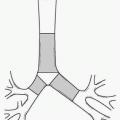Management of Recurrent Ascites
Maye M. Chan
David A. Rosenthal
Ascites occurs in the terminal stages of many malignancies. Its presence severely affects the patient’s remaining quality of life by causing pain, limited mobility, difficulty breathing, nausea, vomiting, early satiety, lower extremity edema, and frequent trips to a hospital for treatment. The goal of management of malignant ascites is palliation, improvement in quality of life, and increased independence. Health care providers can help the patient and family choose a treatment option that best fits the patient’s wishes. Safe and effective treatment options discussed here include paracentesis and tunneled peritoneal catheters.
Paracentesis is a procedure in which a needle is directed into the peritoneal cavity and fluid is removed. Although the procedure may be performed at bedside, image guidance with ultrasound improves both results and safety. Diagnostic paracentesis refers to the removal of small quantity of fluid for analysis; therapeutic paracentesis is performed to alleviate symptoms. Tunneled peritoneal catheters are placed to allow home drainage by the patient or caregiver. Nontunneled drainage catheters and peritoneovenous shunts may also be appropriate management strategies.
Patients are referred for tunneled peritoneal drainage catheters either from their oncologist or an inpatient physician; however, the decision to place a tunneled catheter is often first suggested by the provider performing multiple therapeutic paracentesis procedures. Selection of patients for tunneled peritoneal drainage catheters includes the following patient characteristics:
1. Accepting of catheter and semipermanent status of catheter
2. Motivated to learn a new skill
3. Compliant with medical regimens
4. Amenable to home care follow-up
5. Has a caregiver available for assistance
Indications
Paracentesis
1. Evaluation of new or preexisting ascites
2. Management of symptomatic ascites
3. Drainage of small or loculated fluid collections
Tunneled Peritoneal Catheters
1. Palliation of symptoms caused by recurrent ascites
Contraindications
Absolute
1. Hemodynamically unstable patient
2. Uncorrected coagulopathy
3. Rarely, a lack of safe pathway to drain fluid
Relative for Tunneled Peritoneal Catheters specifically
1. Active infection
2. Life expectancy of days
3. Loculated collections
4. An uncooperative patient or a patient with an inability to understand or comply with medical treatment
Preprocedure Preparation
1. Evaluate patient history, physical examination, and prior imaging studies.
2. For elective procedures when medically appropriate (1)
a. Interrupt oral and intravenous (IV) anticoagulation.
b. Interrupt antiplatelet medication other than aspirin and nonsteroidal antiinflammatory drugs (NSAIDs).
3. Preprocedure laboratory testing is typically not performed for paracentesis unless there is a history of bleeding diatheses, severe liver dysfunction, and/or the patient is anticoagulated. It is performed routinely prior to peritoneal catheter placement.
a. An international normalized ratio (INR) is recommended for patients on warfarin. Consideration can be given for reversal with vitamin K and/or fresh frozen plasma.
(1) Correct the INR to < 2.0 for paracentesis.
(2) Correct the INR to < 1.7 for peritoneal catheter placement.
b. Activated partial thromboplastin time (APTT) is recommended for patients receiving IV unfractionated heparin.
c. Platelet transfusion is recommended for counts under 50,000 per µL.
4. IV access is required for
a. Colloid replacement following large volume paracentesis (> 5 L). Usually, a liter of saline is administered over the encounter.
b. Following removal of 5 or more liters of ascites, particularly in patients with portal hypertension or cirrhosis, an albumin solution of 6 to 8 g per L of fluid can be administered to prevent hypovolemia, hyponatremia, or renal impairment (2).
c. Antibiotic administration prior to tunneled peritoneal catheter. A cephalosporin is recommended for coverage of skin organisms or clindamycin (600 mg) in penicillin-allergic populations.
d. Sedation. Image-guided paracentesis is well tolerated when performed under local anesthesia. Peritoneal catheters are typically performed with sedation. When providing sedation, hospital diet guidelines for sedation are followed.
5. Discuss with the patient or health care proxy the procedure indications, risks and benefits, and alternative options. Obtain consent. Introduction to the care and maintenance of a peritoneal catheter can occur through a detailed discussion by the operator at the time of consent or with the use of helpful digital presentations provided by the device manufacturer, which demonstrate the necessary care.
6. Determine appropriate tests for fluid characterization at the time of initial paracentesis
a. Albumin. Useful to obtain serum to ascites albumin gradient (SAAG) score. SAAG = (ascites albumin value) – (serum albumin value) (3)
(1) SAAG ≥1.1 g per dL predicts portal hypertension (HTN) and a nonperitoneal cause for ascites.
(2) SAAG ≤ 1.1 g per dL indicates that patient does not have portal HTN.
b. Cell count and differential. Corrected neutrophil count of ≥250 per mm3 is suggestive of infection.
c. Total protein
(1) Exudate process if the total protein concentration is ≥2.5 or 3 g per dL
(2) Transudate process if total protein concentration is ≤2.5 or 3 g per dL
d. Lactate dehydrogenase (LDH) concentration. LDH




Stay updated, free articles. Join our Telegram channel

Full access? Get Clinical Tree





